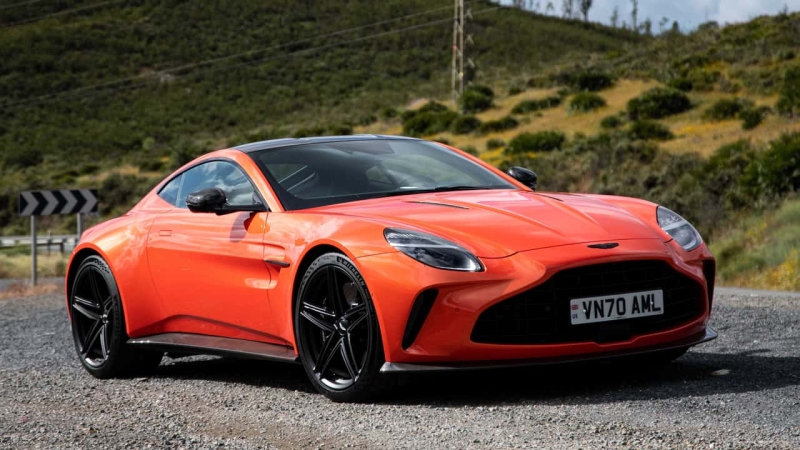The 153 extra horsepower doesn’t tell the full story. The Vantage is fully rethought.
For about as long as the Porsche 911 has been water-cooled, it’s been the benchmark for premium, high-performance sports cars. But the tire-smoking, 656-horsepower brute that is the 2025 Aston Martin Vantage is proof that we, collectively, have been stupid.
Firstly, they fixed it. Almost every gripe was addressed, massaged, or outright improved with new parts. Then Aston Martin went to town adding more, deliberately moving the Vantage upmarket and above the cloudy haze surrounding the mid-$150,000 sports car segment. It now costs a boastful $191,000, which means it’s in a different market segment than the Vantages that came before. Not only has the wick been turned up significantly from a performance perspective, but the Vantage formula has simply been solved.
Secondly, it still does things that a 911 can’t do. More critically, it now does those things without the asterisk of previous Vantages. “Well,” you might have said previously, “the Vantage is more emotional and unique than buying another GT Silver Carrera GTS.” Your monologue continues. “Yeah, the interior is worse, and it doesn’t drive as good. But it’s cooler!” Throw all of that out of the window.
The new Vantage, finally, stands on merit. It’s good, very good, even. But is it truly as complete as it needs to be?
| Quick Specs | 2025 Aston Martin Vantage |
| Engine | Twin-Turbo 4.0-Liter V-8 |
| Output | 656 Horsepower / 590 Pound-Feet |
| 0-60 MPH | 3.4 Seconds |
| Curb Weight | 3,538 Pounds |
| Base Price | $191,000 |
The new Vantage isn’t just an extra 153 horsepower and a new interior—it has been quite thoroughly redone. After a brief video wherein a subtly hostaged Fernando Alonso was almost certainly being told to say nice things by an off-camera Lawrence Stroll, Aston’s new Director of Vehicle Performance, Simon Newton (formerly of a small company called Lotus), outlined a significant number of changes.
The Vantage concept was rebuilt around its bonded aluminum chassis. While overall torsional rigidity increased, total rigidity wasn’t the sole development focus. Rather, Newton’s team focused on increasing the local rigidity in suspension-critical areas: A new firewall, complimented by front suspension tower reinforcements, increases the front local rigidity by 100 percent. Rear rigidity increased by 29 percent with the addition of a strut brace. A retuned electronic power steering system takes advantage of the changes.
Leveraging gains from that more-rigid structure, the team retuned every facet of the suspension. New kinematics (essentially, the suspension’s geometric behavior under load), new Bilstein DTX adaptive dampers with a 500 percent wider range of stiffness, and retuned springs and sway bars work to improve performance over the previous Vantage. Everything works through a set of Vantage-specific Michelin Pilot Sport S 5 tires in the same sizing as the larger DB12.
Then there’s the Aston’s nuclear-bomb engine. The 4.0-liter twin-turbo V-8 from Mercedes-AMG is not simply a re-tuned, off-the-shelf unit. Not only are the turbochargers larger here, but more-aggressive cams are fitted, the engine’s combustion chambers are CNC ported, and there’s a significantly lowered compression ratio. Each improvement tells the story of a more-heavily boosted engine. Where the previous Vantage used a 10.5:1 compression ratio, the 2025 model uses an 8.6:1 ratio; identical to the 605-horsepower variant AMG installed in the E63 and S63. Yet the Aston nets a colossal 656 horsepower, the most powerful variant of the AMG 4.0-liter V-8 ever created.
But wait, there’s more. A new nine-stage traction control system allows drivers to precisely control the percentage of wheel slip relative to road speed. While the latest Bosch integrated vehicle controller uses brake vectoring, the electronically controlled limited-slip differential and the Vantage’s adaptive dampers to run the show. The hardware is good, with the E-diff capable of going from fully open to 100 percent locked in 135 milliseconds. But the software is where the real party (at least, engineering-wise) starts.
A dizzying array of acronyms dominate the Vantage experience. The 6D-IMU inertial measurement unit tracks the Vantage’s movements in six axes, while the Integrated Brake Slip Control (IBC) program actively manages per-wheel brake force to provide optimal yaw and attitude on corner entry, which is called Brake Slip Vectoring (BSV). The Integrated Traction Control (ITC) combines the brakes, engine output, and E-diff to control wheelslip, while Traction Slip Vectoring (TSV) optimizes wheel slip to achieve the desired yaw angle. Basically, there’s a shitload of vectoring happening to make the Vantage dance.
The most significant change is an all-new interior, unified in spirit with the DB12. Aston throws everything away from the previous car, a welcomed good riddance. This Vantage proves significantly more usable, with supremely satisfying knobs and switches made from weighty, knurled metals. Finally, there’s CarPlay, and it’s wireless.
The interior still has some snags. It’s easy to bump the heated seat selector while adjusting volume, and the gauge cluster runs at a frame rate and resolution that wouldn’t be acceptable in a Subaru WRX. Aston is working on fixes, it assures us.
OK, everyone. We can drop the weary optimism almost every Aston of the last decade has required. In practice, the 2025 Vantage presents as an almost completely new vehicle, with the echoes of the previous generation only visible to the most sensitive of hands and asses.
The Aston nets a colossal 656 horsepower, the most powerful variant of the AMG 4.0-liter V-8 ever created.
Aston has long ridden the opulent-chintzy line but lacked the tasteful refinement to be totally convincing. It’s something that Porsche sidesteps using clean design language that appeals to people with pea-gravel driveways and turf lawns. It only took a few years, but this newest Vantage is finally a true expression of the glitz that the Aston brand has always promised.
Simultaneously, it is the greatest expression of the roguish, pub-brawling brute that the Vantage should be. On the road, it doesn’t lose out in comfort when compared to the previous Vantage, even with a more performance-focused philosophy underpinning the new car. Road noise is well managed and ride quality in every mode is excellent, less punishing than before.
There’s a newfound precision to the way the Vantage attacks a winding road, though it’s not always easy to wrangle. Even with Aston boasting significant chassis and steering improvements, the steering still lacks an authoritative build up of weight off-center, transmitting only a tantalizing hint of what could be, thanks to strong on-center feel. It takes a bit of hustling to get the Vantage to come alive, and low speed carving wasn’t that satisfying. The new suspension feels excellent, light on its feet and agile, but never stiff and punishing. It’s precise, exacting, and forgiving in its ride quality. A magic trick.
But hell, if the Vantage isn’t a hooligan. There’s that prodigious, borderline-shocking power, kept in check by its team of acronyms. The multi-stage traction control system feels deeply clever, allowing cheeky street slides to feel like child’s play. Laying off the power reveals a chassis balance to rival a Subaru BRZ. The ease with which the Vantage can be driven to that comfortable pocket just ahead of its limits, despite its power and weight, is impressive. Even if the car’s body communicates most of its moves through your seat, rather than the steering wheel. Rather than a completely unhinged lunatic, the Vantage is like Patrick Bateman, a high-functioning psychopath in the best-looking suit you’ve ever seen.
This character doesn’t change massively on the test track. The Vantage simply expands its domain, absorbing nonstop 25-minute track sessions with only the tiniest hint of brake fade. Even that is to be expected–Monteblanco, the test track in question, has a straightaway good for 165 mph in the Vantage. At the end of the straightaway is a 130-degree right hand turn with a minimum speed hovering around 50-60 mph. I’m amazed the carbon ceramic brakes didn’t glaze, and I’m equally amazed at the advancements Michelin made with the Pilot Sport S 5. Whereas previous Michelins would delaminate under extreme conditions, these new tires take huge, smokey drifts and sustained abuse without a hint of a complaint.
Even if it wasn’t totally meant for it, the Vantage makes for a lovely and impressive track tool. Aston tuned the brakes for a short, stiff pedal feel with a low-bite friction material for easy modulation. Some drivers may complain of a lack of bite, but the more experienced will welcome the granular adjustability. Slides were easy to initiate but difficult to sustain without solid commitment, and transitions were also difficult to manage thanks to the steering never quite coming alive.
The Vantage will drive how you want it to–It’s comfortable doing colossal drifts or driving the straight-and-narrow for lap times. The front axle could be easily overwhelmed on corner entry, but with a bit of responsibility and judgment, the Vantage would tuck and turn. The long throttle pedal makes it easy to delicately proportion power, and the effect is satisfying to master.
It’s a massive step forward for the baby Aston. And despite me saying that comparing the car to a 911 would be stupid, I’ll only say it for this: The 2025 Vantage is a true 911 Turbo killer. It does the thing. It’s more exciting to drive than the Porsche, it’s more comfortable, it’s quieter, and it rides better. It sells more of a fantasy. But the Aston doesn’t quite reach the dynamic heights the 911 grasps so effortlessly. The Porsche has superior engagement, steering feel, and handling.
But the Aston is quite possibly the better overall package for the first time in its history. It is mightily impressive. And unlike a 911 Turbo, I can grab fourth gear mid-drift and scumbag a vehicle worth about as much as the average home. The Vantage makes you smile and giggle, it’s an activation of your inner child rather than a sobering, logical, adult object. And as corny as it sounds, it makes you fall in love.
Competitors
- Ferrari Roma
- Lamborghini Huracan Tecnica
- Porsche 911 Turbo
Get the best news, reviews, columns, and more delivered straight to your inbox, daily. Sign up For more information, read our
Privacy Policy and Terms of Use.
Gallery: 2025 Aston Martin Vantage First Drive Review
2025 Aston Martin Vantage
Engine Twin-Turbocharged 4.0-Liter V-8
Output 656 Horsepower / 590 Pound-Feet
Transmission Eight-Speed Automatic
Drive Type Rear-Wheel Drive
Speed 0-60 MPH 3.4 Seconds
Maximum speed 202 Miles Per Hour
Weight 3,538 Pounds
Seating Capacity 2
Base Price $191,000



